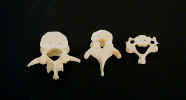

 Posterior view
Posterior view Superior view
Superior viewThe twelve thoracic vertebrae are easily recognized because from the posterior side they look like the head of a giraffe. That is not a good answer for a quiz, but it may help you make a quick identification. Remember the movie "Thoracic Park" with all the giraffes! The reasons that should be used on a quiz include the long spinous process that points in an inferior direction. Also, we find the transverse process projects posteriorly like a "V". We find articulations for the ribs including the transverse costal facet, the superior costal demifacet, and the inferior costal demifacet. Exceptions to this would include thoracic vertebra 1 and thoracic vertebrae 10 through 12. They typically have a single facet on the lateral side of the vertebral body. Thoracic vertebrae 11 and 12 lack a transverse costal facet. Lastly, the articulations between adjacent vertebrae are nearly in a coronal plane. This effectively prevents flexion and extension, but does allow for rotation of the vertebral column. Lateral flexion should be possible, but this motion is prevented by the presence of the ribs. Functionally, the limited movement of thoracic vertebrae is important to provide a volume in which the lungs and heart can undergo changes in volume without risk of compression.
COPYRIGHT
2007 by William C. Johnson II
ALL RIGHTS RESERVED!